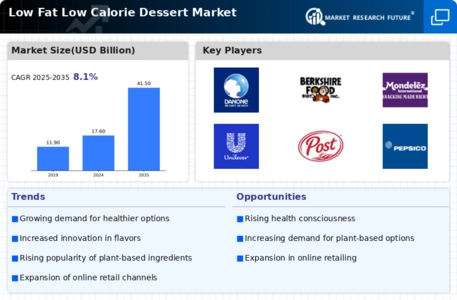Rising Health Awareness
The increasing awareness regarding health and wellness among consumers appears to be a primary driver for the Low Fat Low Calorie Dessert Market. As individuals become more conscious of their dietary choices, the demand for healthier dessert options has surged. According to recent data, approximately 60% of consumers actively seek low-calorie alternatives to traditional desserts. This trend is particularly pronounced among millennials and Gen Z, who prioritize health and fitness. Consequently, manufacturers are responding by innovating and reformulating their products to meet these evolving preferences. The Low Fat Low Calorie Dessert Market is thus witnessing a shift towards offerings that not only satisfy sweet cravings but also align with health goals, potentially leading to sustained growth in this segment.
Influence of Dietary Trends
The influence of various dietary trends, such as keto, paleo, and veganism, is shaping the Low Fat Low Calorie Dessert Market. These dietary movements often emphasize reduced sugar and fat intake, which aligns well with the characteristics of low-calorie desserts. Market Research Future indicates that products catering to these dietary preferences have seen a 40% increase in consumer interest over the past year. As more individuals adopt these lifestyles, the demand for desserts that fit within these frameworks is likely to rise. Manufacturers are responding by developing innovative products that not only meet dietary restrictions but also provide indulgent flavors. This alignment with popular dietary trends is expected to bolster the growth of the Low Fat Low Calorie Dessert Market, as consumers seek options that satisfy both their health goals and taste preferences.
Expansion of Retail Channels
The expansion of retail channels is significantly influencing the Low Fat Low Calorie Dessert Market. With the rise of e-commerce and the proliferation of health-focused grocery stores, consumers now have greater access to a variety of low-calorie dessert options. Recent statistics suggest that online sales of health-oriented products have increased by 30%, indicating a shift in shopping behavior. Retailers are also dedicating more shelf space to low-fat and low-calorie products, making them more visible and accessible to consumers. This increased availability not only caters to the growing demand but also encourages impulse purchases, thereby contributing to the overall growth of the Low Fat Low Calorie Dessert Market. As more consumers seek convenient and healthier dessert options, the expansion of these channels is likely to continue driving market dynamics.
Growing Demand for Convenience Foods
The growing demand for convenience foods is a significant driver for the Low Fat Low Calorie Dessert Market. As lifestyles become increasingly hectic, consumers are seeking quick and easy dessert options that do not compromise on health. Recent data indicates that ready-to-eat and on-the-go dessert products have experienced a 35% increase in sales. This trend is particularly evident among busy professionals and families who prioritize convenience without sacrificing nutritional value. Manufacturers are responding by creating single-serve packaging and ready-to-eat options that cater to this need. The Low Fat Low Calorie Dessert Market is thus positioned to benefit from this trend, as consumers continue to seek out convenient yet healthy dessert alternatives that fit seamlessly into their busy lives.
Increased Availability of Natural Ingredients
The Low Fat Low Calorie Dessert Market is experiencing a notable shift towards the use of natural and organic ingredients. As consumers become more discerning about food quality, there is a growing preference for desserts made with wholesome components. This trend is reflected in market data, which indicates that products labeled as organic or containing natural sweeteners have seen a 25% increase in sales over the past year. Manufacturers are increasingly sourcing ingredients that are perceived as healthier, such as stevia and coconut flour, to cater to this demand. This focus on natural ingredients not only enhances the appeal of low-fat desserts but also aligns with broader consumer trends towards clean eating, thereby driving growth in the Low Fat Low Calorie Dessert Market.


















Leave a Comment